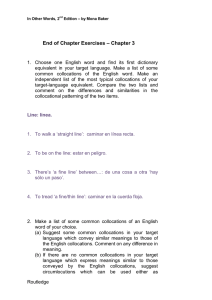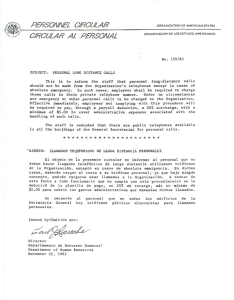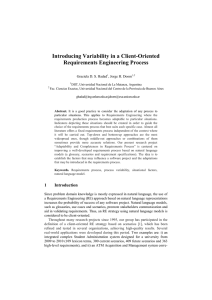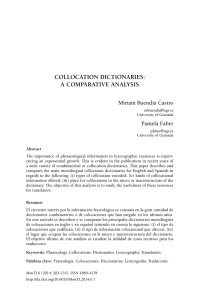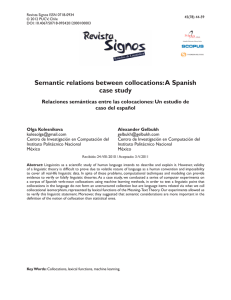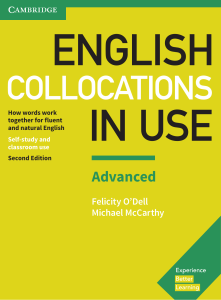A modo de síntesis valorativa, destacaríamos, en primer lugar, la
Anuncio
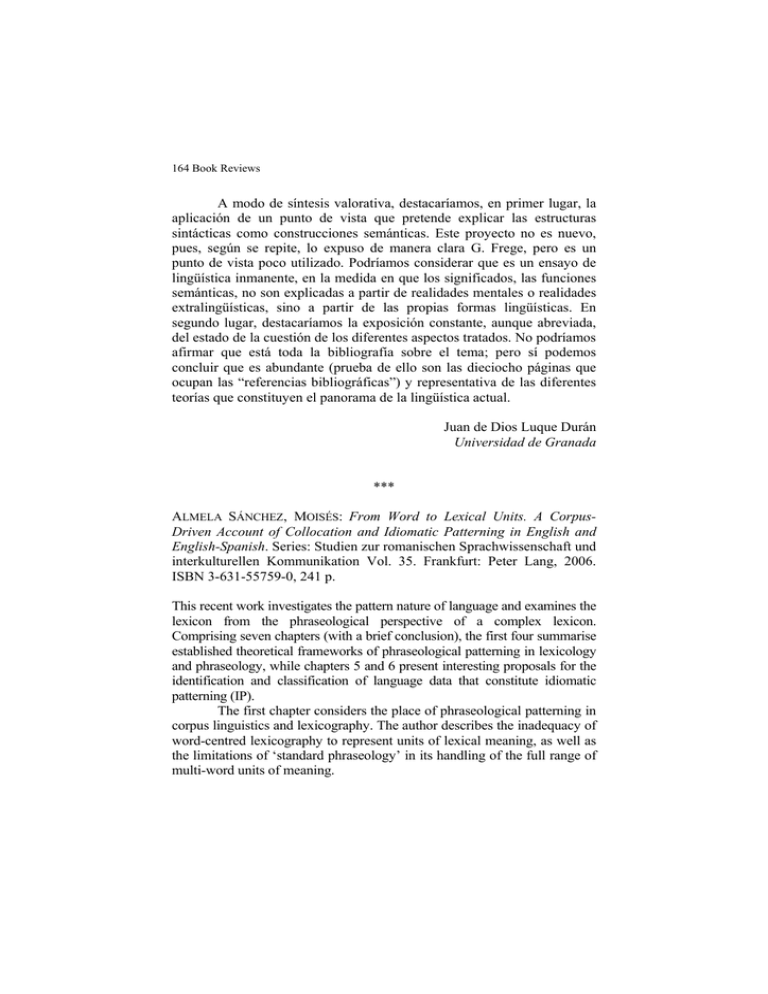
164 Book Reviews A modo de síntesis valorativa, destacaríamos, en primer lugar, la aplicación de un punto de vista que pretende explicar las estructuras sintácticas como construcciones semánticas. Este proyecto no es nuevo, pues, según se repite, lo expuso de manera clara G. Frege, pero es un punto de vista poco utilizado. Podríamos considerar que es un ensayo de lingüística inmanente, en la medida en que los significados, las funciones semánticas, no son explicadas a partir de realidades mentales o realidades extralingüísticas, sino a partir de las propias formas lingüísticas. En segundo lugar, destacaríamos la exposición constante, aunque abreviada, del estado de la cuestión de los diferentes aspectos tratados. No podríamos afirmar que está toda la bibliografía sobre el tema; pero sí podemos concluir que es abundante (prueba de ello son las dieciocho páginas que ocupan las “referencias bibliográficas”) y representativa de las diferentes teorías que constituyen el panorama de la lingüística actual. Juan de Dios Luque Durán Universidad de Granada *** ALMELA SÁNCHEZ, MOISÉS: From Word to Lexical Units. A CorpusDriven Account of Collocation and Idiomatic Patterning in English and English-Spanish. Series: Studien zur romanischen Sprachwissenschaft und interkulturellen Kommunikation Vol. 35. Frankfurt: Peter Lang, 2006. ISBN 3-631-55759-0, 241 p. This recent work investigates the pattern nature of language and examines the lexicon from the phraseological perspective of a complex lexicon. Comprising seven chapters (with a brief conclusion), the first four summarise established theoretical frameworks of phraseological patterning in lexicology and phraseology, while chapters 5 and 6 present interesting proposals for the identification and classification of language data that constitute idiomatic patterning (IP). The first chapter considers the place of phraseological patterning in corpus linguistics and lexicography. The author describes the inadequacy of word-centred lexicography to represent units of lexical meaning, as well as the limitations of ‘standard phraseology’ in its handling of the full range of multi-word units of meaning. Book Reviews 165 Almela Sánchez uses the terms collocation and colligational patterning to describe meaningful combinations ranging from loose collocations to pure idioms. All such combinations are manifestations of IP present “wherever there are semantic features that can be observed for a group of (co-occurring) words but not for the same words in abstraction from the cluster” (p.26). Throughout the work, the author discusses the lexical system within its IP context, thus underscoring the lack of autonomy of lexical meaning. Clearly favouring corpus linguistics (CL) as a research framework, the author employs three data bases in this study: the Bank of English, the LACELL Corpus (an English/Spanish corpus located at the English Department at the University of Murcia), the Cumbre Corpus (a Spanish corpus purchasable from SGEL publishers). The idiomatic patterning of a variety of data drawn from these sources is discussed, although the methodology used is not indicated, an aspect which would no doubt interest readers. The following chapter accentuates the centrality of the idiom principle in language and espouses a broadened and enriched appreciation of idiomatic language. The author revises our understanding of the idiom principle in terms of frequency, volume, and scope, arguing that IP is more frequent, and that our vocabulary comprises more units of this kind than previously suspected, a claim which logically leads to a revision of the boundaries of IP. As discussions on meaning in ‘standard phraseology’ are central to the definition of idiomatic language, the author explores this feature in some detail, positing a three-layer analysis: a prosodic, a specialized and a lexemic layer. Taking the example of strong case, the prosodic layer constitutes the holistic meaning independent of component boundaries; thus the combination is used to express ‘the process of supporting or rejecting an opinion’, a meaning which cannot be extracted from either word, as the accompanying corpus analysis shows. Specialized meaning refers to the allocation of the meaning ‘facts and arguments’ to one component only, case. Finally, the lexemic layer refers to the constant word meaning, the features manifested by the word across its various usages, which in this example would be the feature ‘intensification’ contributed by the component strong. The three layers interact to produce the full meaning. In chapter 3, the author discusses the degree of fixedness of two types of idiomatic language at opposite ends of the traditional phraseological continuum: idioms and collocations, or pure and impure IP, 166 Book Reviews ascertaining that pure idioms are closer to other types of IP than hitherto claimed. The author refutes the tenet that pure idioms, or ‘small-scale idiomatic patterns’ (SSIP), are non-analysable, and anticipates chapter 6 by alluding to the different types of variation they may undergo. Moreover, the highly specialized meaning of pure idioms is not held to be a feature that distinguishes these from other forms of IP, but rather it is simply equated with highly restricted prosodic meaning. On the other end of the continuum, the author categorises the, frequently rather vague, definitions of collocations as conforming to one of three types: negative definitions (a collocation is neither a free combination or an idiom), descriptive definitions (prototypical collocations possess a series of characteristics), and derived definitions (collocations are defined as constituting the lexico-syntactic interface).The author subsequently outlines the three conceptualizations of collocations in non-corpus driven models: collocation as lexical function (the Meaning-Text model of Mel’čuk and Žolkovskij, 1970); collocation as a semi-phraseological unit; collocation as a lexical syntagmatic restriction (as recently applied by Bosque in the dictionary Redes). Chapter 4 discusses the Firthian approach of ‘meaning by collocation’; Almela Sánchez suggests this should be superseded by ‘meaning by collocational patterning’, thus involving a shift of the unit of analysis. He argues against the power of context to select particular meanings of a word by using the example of previous conviction and conviction that, as previous could potentially select either the meaning prejudice or criminal record. In other words, were collocations semantically compositional, this would be an ambiguous combination. The author cites further examples of take a picture and friendly fire to support the claim that collocations possess meanings as units, and their components are co-selected, i.e. selected as units. Chapter 5 outlines the structure of the complex lexicon. Unlike mainstream linguistics that reserves idiomatic meaning for descriptions of phraseological combinations, here idiomaticity is viewed as a structural level of language. The author proposes four structuring principles to describe patterns in text. First, the ‘multilayered distribution of meaning’ consists of the tripartite division discussed earlier of prosodic, specialised, and lexemic meaning. Next, ‘comprehensive actual meaning’ refers to the idiomatic and compositional dimensions and suprasegmental and segmental modes of meaning arising from a textual analysis of language. Thus, chunks of language, the consequence of co-selection as discussed in the preceding Book Reviews 167 chapter, are viewed as both complex and analysable rather than simply monolithic units. The third principle, ‘graded monosemy’, refines the view of word meaning essentially seen in function of its environment, identifying degrees of autonomous meaning. Finally, the principle of ‘signical complexity’ maintains that the syntagmatic behaviour of individual words is discourse dependent, as can be seen in the fixed order of binomials (the gap between the rich and poor) and apparent inconsistencies in nymic relations (That’s rich/*poor coming from X). The author suggests that this revised view of the lexicon has beneficial applications for translators and lexicographers grappling with decisions on meaning and meaning equivalency, although there are no clear examples of how these structuring principles may be applied. Where chapter 5 outlines the structure of the complex lexicon, chapter 6, ‘Structure of meaningful patterning’, analyses the units comprising the complex lexicon, identifying categories of variations across idiomatic patterning. Almela Sánchez’s contribution in this chapter is to describe flexible and fuzzy patterning by identifying what remains constant, what is variable but to be expected, and what is unpredictable in the manifestation of the pattern. The author demonstrates how the range of variation permitted across IP may differ, for example, the range possible in any [class, sort, kind, type] of is broader than any number of. The term ‘realizational proportions’ is used to refer to the number of possible variations manifested in a unit of IP, with a lower the number indicating a more restricted IP unit. Thus, pure idioms are simply those with minimal realizational proportions, while more flexible phraseological patterns represent examples of IP with broader realizational proportions. Following Sinclair (1998), the author identifies ‘core’, or constant, components of IP such as put it in: let’s put it [this, that, another, the other way] / as X put it / to put it – ly. The minimal core constitutes the upper rank pattern, while alternate realizations form lower rank patterns. These may also include additional core items required for the recognition of a lower rank pattern, but which are not found in the upper rank pattern, e.g. to + -ly are necessary for the recognition of to put it –ly. The different components of any IP may be classified with regard to their ability to modify meaning, their contribution to pattern recognition, and their role in paradigmatic variation. The following is a brief summary of IP component types with examples: 168 Book Reviews Fixed kernels: do not enter into paradigmatic variation (put it) Variable kernels: variation is allowed (nearly / almost died) Core modulators: modify meaning (a [gap, space, interval] of [year, months, weeks, days, hours]) Optional modulators: not necessary for the recognition (not in: to be not in the nature of X) Optional elements: included but do not modify meaning (e.g. in in: to be in the nature of X) Free variables: virtually unrestricted lists of paradigmatic variation (e.g. X in: to be in the nature of X) Finally, chapter 7 involves a broad discussion of why the language system comprises a complex lexicon rather than a simplex lexicon. In summary, the author contributes to our understanding of IP in the following areas in particular: the scope of idiomatic patterning in language (how do we delimit the structures that form part of IP?), the tension between analysability and holistic chunking of IP (what are the fundamental properties of IP?), and the categories of IP (which characteristics are common to all IP and which are specific to certain types of patterning exclusively?). Louisa Buckingham Sabanci University, Istambul *** HEINE, ANTJE: Funktionsverbgefüge in System, Text und korpusbasierter (Lerner) Lexikographie. Serie: Finnische Beiträge zur Germanistik, Vol. 18. Frankfurt: Peter Lang, 2006. ISBN 978-3-631-55249-0. 270 p. This book, product of the author’s doctoral thesis at the University of Leipzig supervised by Dr. Barbara Wotjak, places Funktionsverbgefügen (FVG) within the framework of learner lexicography, and it contributes to our understanding of how data extracted from electronic corpora can be employed in language description. The method proposed is not only relevant to inter- and intra-lingual FVG analysis, but it may also be used to investigate other phraseological combinations. The author identifies the work of von Polenz (1963) as key to the early linguistic study of FVG in Germany. While initially researchers


